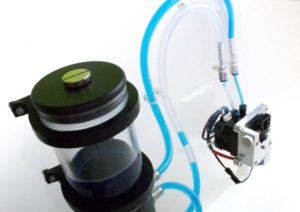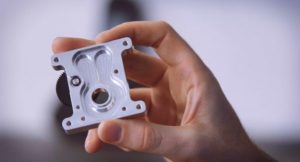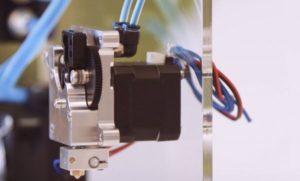 If there’s one thing that UK-based E3D knows, it’s the maker community’s constant need for high-quality 3D printing parts, which is why the company specializes in extruders, hotends, and combinations of the two parts. Without a precise hotend to transform your 3D printing filament into molten hot plastic as it’s extruded out of the nozzle and onto the build platform, you won’t get good print results. Now, E3D is releasing two new products, the water-cooling Titan Aqua hotend and the E3D water-cooling kit, which work together to help keep the hot 3D printing environment safe.
If there’s one thing that UK-based E3D knows, it’s the maker community’s constant need for high-quality 3D printing parts, which is why the company specializes in extruders, hotends, and combinations of the two parts. Without a precise hotend to transform your 3D printing filament into molten hot plastic as it’s extruded out of the nozzle and onto the build platform, you won’t get good print results. Now, E3D is releasing two new products, the water-cooling Titan Aqua hotend and the E3D water-cooling kit, which work together to help keep the hot 3D printing environment safe.
According to an E3D blog post, “The primary use-case for water-cooled HotEnds in 3D printers is when using heated chambers or passively-heated enclosures.”
Heated chambers, which are necessary when you’re printing with some high-performance and engineering filaments, make use of an active heating element. But, the only thing necessary to warm the air, so materials like ABS won’t warp from cold, inside a 3D printer with a passively-heated enclosure is the heat generated from the print bed. This can be accomplished by putting a box around the printer or a plastic sheet over the front, but can cause issues later on, such as less effective cooling when you’re attempting to use warm air to cool down a hotend.
“This creates a less-sharp thermal transition for the filament, and therefore less precise printing. Expect oozing, blobbing, and stringing,” E3D wrote. “Even good-quality fans like the ones we use for V6 and Titan Aero also start to fail at around 45°C – 50°C, and motors (which generate their own internal heat) aren’t keen either. Conversely, the air moving around the heatsink fan creates pockets of turbulent, cooler air. This risks more warping of the printed plastic, negating the benefit of a heated chamber. Fans are also noisy and can vibrate at high speeds.”
The Titan Aqua, based on the company’s classic Titan Extruder, does actually use a large fan for cooling, but rather than situating it next to the part on the print head, it’s mounted outside of the chamber. It also has a quieter operation, since it doesn’t have to spin as fast as a regular-sized fan would.
The water in the system is used as a coolant, and transfers heat from the hotend, which is mounted onto the face plate of the extruder motor, to a radiator that’s attached to the fan, where it is dissipated. The Titan Aero is designed to have coolant circulate inside its metal body, so it carries away the heat and keeps the part cool. The water-cooling channel is wide, in order to remove metal and reduce weight, while at the same time maximizing the water-flow and heat-transfer area.
Because of electrical power dissipation, motors do create heat internally, and can fail if they reach over 80°C. But the Titan Aqua’s internal cooling helps the extruder’s motor run at the optimal temperature. If flowing water channels located near an electrical motor makes you a little nervous, fear not – the Titan Aqua is, in the words of E3D, “very watertight indeed,” thanks to a gasket system with a custom, tight-fitting seal.
 Though the Titan Aqua’s design is not quite ideal, in that the body and the guide are separate parts fixed together with less than ideal thermal contact, it does offer a few benefits:
Though the Titan Aqua’s design is not quite ideal, in that the body and the guide are separate parts fixed together with less than ideal thermal contact, it does offer a few benefits:
- Makes it easier to assemble other components
- Makes manufacturing simpler and less expensive
- Allows users to create variants for different filament sizes
The Titan Aqua has the same “tried-and-tested” 3:1 gearing ratio, idler mechanism, and sharp-toothed custom-machined hobb that make the original Titan Extruder so precise, reliable, and easy to use. It is also compatible with V6 hot-side parts, and even Volcano parts; the company suggests several upgrades, including a PT 100 temperature sensor, a titanium heat break, and high-precision heat cartridge, to add “super-heated synergy.”
E3D said, “We’ve also carried through everything we learned while designing Titan Aero: we’ve kept the all-metal design and the compact, rigid body, while adding a cantilevered hobb shaft. This lowers the axial load placed on the shaft and makes the design more open from the front. It’s basically a water-cooled Aero with an even sharper thermal transition to further increase flow accuracy and reduce risk of jamming. We’ve also changed up the mounting style, so that you can assemble it independently before mounting it on your printer. This is a godsend when tinkering with enclosed printers, which aren’t known for their internal roominess.”
The company developed a new water-cooling kit, with standard, off-the-shelf parts that can be easily modified, and the pump and reservoir are combined into one quiet unit, similar to the fan and radiator. They also added flexible, slim nylon tubing, which uses adaptors to attach to the hotend and can be “easily routed through cable chains.”
E3D recommends that you use a water-based coolant with both the water-cooling kit and the Titan Aqua, which contains all of the necessary distillation and anti-fungal salts so the parts don’t get too gunked-up.
Discuss this and other 3D printing topics at 3DPrintBoard.com or share your thoughts below.
[Images: E3D]
Subscribe to Our Email Newsletter
Stay up-to-date on all the latest news from the 3D printing industry and receive information and offers from third party vendors.
Print Services
Upload your 3D Models and get them printed quickly and efficiently.
You May Also Like
3D Printing News Briefs, July 2, 2025: Copper Alloys, Defense Manufacturing, & More
We’re starting off with metals in today’s 3D Printing News Briefs, as Farsoon has unveiled a large-scale AM solution for copper alloys, and Meltio used its wire-laser metal solution to...
3DPOD 260: John Hart on VulcanForms, MIT, Desktop Metal and More
John Hart is a Professor at MIT; he´s also the director of the Laboratory for Manufacturing and Productivity as well as the director of the Center for Advanced Production Technologies....
3D Printing News Briefs, June 28, 2025: Defense Accelerator, Surgical Models, & More
In this weekend’s 3D Printing News Briefs, 3YOURMIND was selected to join an EU Defense Accelerator, and PTC has announced model-based definition (MBD) capabilities within Onshape. Finally, a study out...
EOS in India: AM’s Rising Star
EOS is doubling down on India. With a growing base of aerospace startups, new government policies, and a massive engineering workforce, India is quickly becoming one of the most important...







































